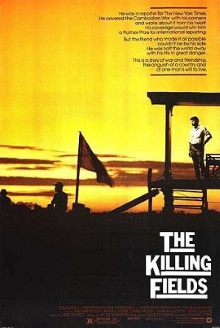
As my wife and I are travelling to Cambodia on holiday later this month, she insisted on watching this one as soon as possible, upsetting my carefully thought out schedules and lists. This is a film that made waves when it was released and I remember it being shown often on television when I was a child but I’ve never sat down and watched it properly. Perhaps the Malaysian authorities were very happy about its anti-Communist messaging?
In 1973, Sydney Schanberg is the foreign correspondent for the New York Times in Phnom Penh and Dith Pran is his interpreter. They learn that an American B-52 bomber has mistakenly bombed the town of Neak Leung and that the government is trying to cover it up and witness Cambodian government soldiers execute Khmer Rouge fighters on the streets. Fast forward two years later and it is the government that is on the back foot and the Khmer Rouge is on the verge of capturing Phnom Penh. Schanberg arranges for Pran’s family to be evacuated to the US along with most of the other foreigners but it is clear that he intends to stay to cover the events and Pran insists on staying with him. However it soon becomes clear that the new regime is a brutal one and they are forced to take refuge in the French embassy. Eventually foreigners are allowed to leave the country but Pran is forced to endure four years in a labor camp. There he witnesses the horrible atrocities that would prompt him to later call those places the killing fields.
It is only to be expected that a film of this caliber is competently put together, with the performance by Haing S. Ngor as Pran being the most noteworthy, given that he is a non-professional actor who was himself a real life survivor of the prison camps. However this is very much a case of a film being good more due to the worthiness of its subject matter than to its craftsmanship. It has to be said that the scene of Pran stumbling across the actual killing fields is incredibly intense even though you know that it’s coming. The sight of him being forced to make his way through the gory bits and pieces of what used to be people is simply indescribable. The film also does a decent job of capturing the rising fear in Phnom Penh as the Khmer Rouge approach ever closer as well as their desperation as they seek a way to help Pran escape with them when they’re cooped up in the embassy. But this is something we’ve seen before in films like Last Days in Vietnam and Hotel Rwanda and there’s nothing outstanding.
The most irksome thing about this is that it treats Schanberg as the protagonist for the first half of the film and then switches focus to Pran in order to cover his time in the labor camps while Schanberg is safely in America. It would have been far better to let Pran be the main character throughout the film and tell the whole story through his eyes. One great scene is when the Khmer Rouge first enter the city and there is a brief moment of euphoria when it seems like the change of regime will be peaceful. Pran, for all his worldliness and education, is caught up in it and ecstatic that the fighting is finally over. That’s a perspective that is possible only because Pran is a Cambodian and I wish that there had been more scenes like that. Instead the film spends too much time on the doings of Schanberg and the other western journalists. While those scenes are interesting enough, they aren’t unique and that makes all the difference to me.
I also found myself being disappointed that the film provides very little information about the situation as a whole. Granted, this isn’t a documentary and sticking close to the main characters like this helps it stay grounded and honest but some context would be nice. I like to contrast this approach to that of more modern films like for example Margin Call, which has completely fictional characters but do a great job of capturing the essence of some historical event. Seen that way, The Killing Fields is very inadequate as a film about the Cambodian genocide but a solid representation of one man’s experience of it. Still, it’s undeniable that this film opened the eyes of many Westerners to what happened in Cambodia and inadequate as it is as a historical record, it’s way better than no film at all and remains a a very worthwhile watch.